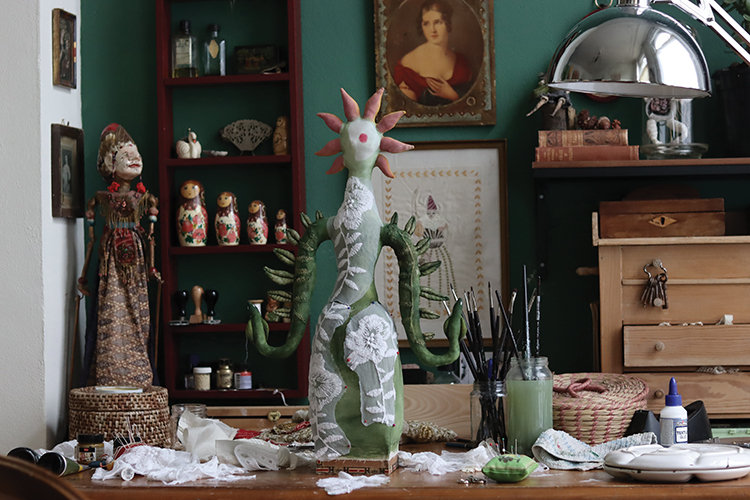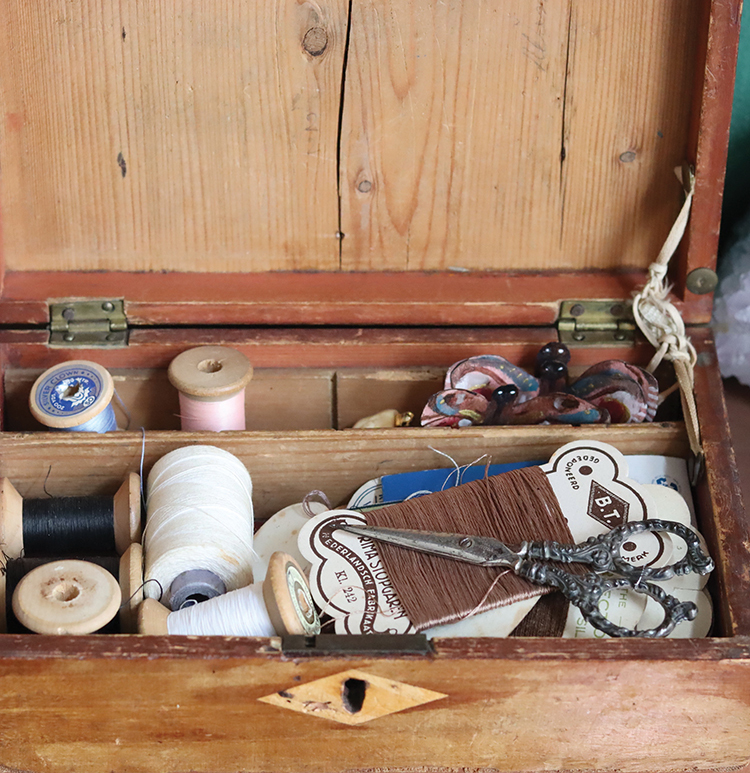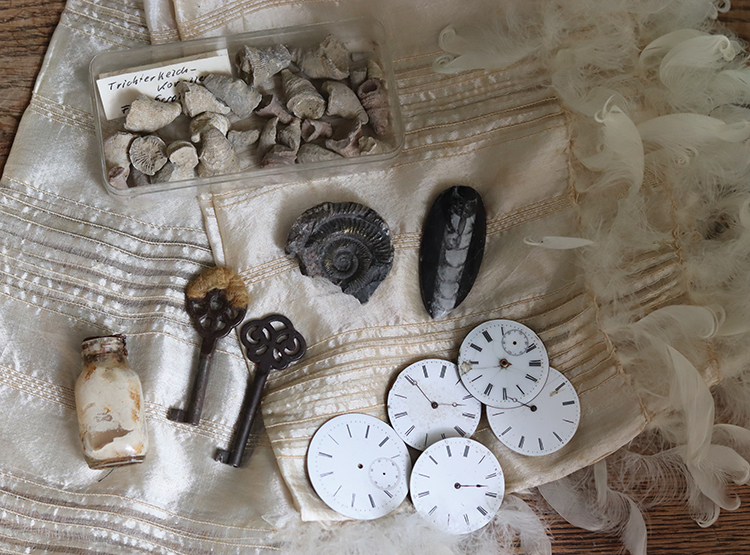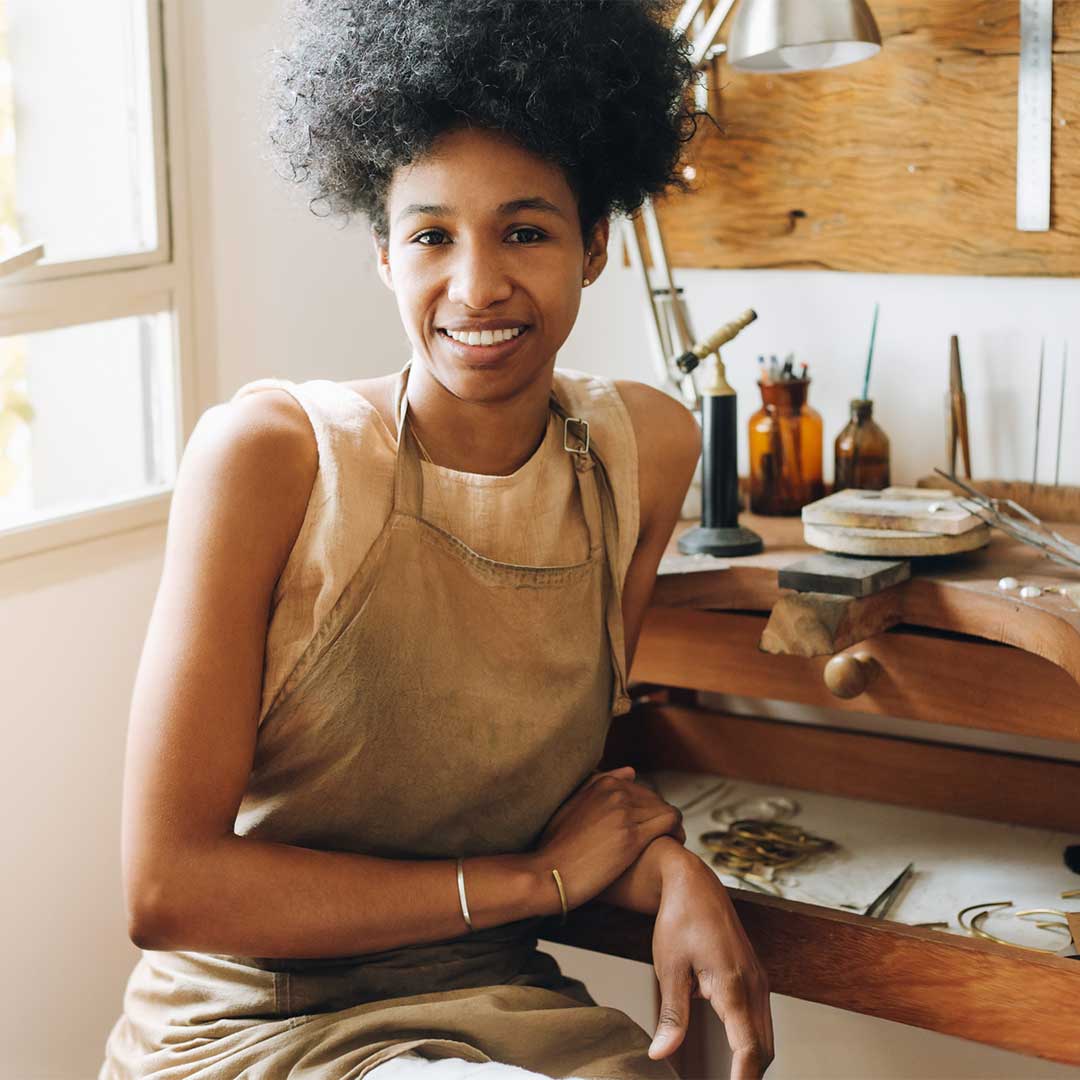
I was born many moons ago in a small country called Wladi Ladilu as the seventh and youngest daughter of a mighty emperor and a Persian princess. A small castle with tall crumbling towers overlooking the evergreen woodlands of wolves and witches was my home and our beloved pet, the Great White Swan was my favourite childhood companion.
For as long as I can remember I have been thinking up stories and creating. I have always surrounded myself with my paintings, murals and sculptures of inner landscapes and wondrous creatures inhabiting them. It has been, and still is, a way for me to make visible a world that exists inside of me, in which I can roam and grow and find my autonomy as my authentic self.
I look at the work that I make as images of what is already alive inside my soul: an ever-growing landscape of light and dark, of magical mountains and woodlands in which half-forgotten childhood memories and half-remembered dreams live among the winged wolves and witches.
One of my earliest art memories is of creating sock dolls — an old sock stuffed with cotton wool with a face painted on — at the kitchen table with my mother. Giving life and character to seemingly “dead” materials was a mystifyingly wonderful and empowering experience. When I got a little older, we made papier-mâché puppets.
Then I began to paint murals on the walls of our home: first, my own bedroom, and then, when those were covered, I expanded my artistic endeavours to the hallway, the kitchen, the bathroom. … I was very lucky that my mother, the Persian Princess, delighted in these explosions of my childhood creativity.
Another place I found myself very happy in was the theatre. When my grandmother, the Old Spinning Witch, took me to see a puppetry show in an old farm barn, this sparked an enduring passion in me for the bewitching illusion of the theatre.

It did not surprise me, therefore, to learn that my real father was in fact not the terrifically terrifying emperor ruling Wladi Ladilu, but in fact a mysterious man from the Blue Moon Mountains; a magician who, accompanied by his old speaking owl, traveled the world far and wide with his Theatre of Tales to tell stories of the most magnificent kind. One fateful night, when I was 11 years young and my older siblings had flown the nest, my mother and I escaped from the castle on the back of our Great White Swan to join the magician and his traveling theatre. This is where I spent the remaining years of my childhood and where I met Bragi, the melancholy Pierrot who cried pearl teardrops each night of the full moon and who would become the object of my tender affection.
I joined a youth theatre school and found myself especially mystified by the costumes and masks, the decorations and the dusty red velvet curtains separating the enchanted world from the real one. At home, I recreated this magic in small format by making miniature theatres inside shoeboxes, and shadow theatres using Japanese rice paper with puppets cut from card.
Miniature worlds have always drawn me in and this love for the small came to a high peak when I was studying at art school, and was able to use the film studio. There, I took a deep dive into bringing the miniature worlds to life completely, making stop-motion puppet animation films using my own puppets and decorations.
After graduating, I spent several years working with a group of artists on a project creating art films in which music and costume were the beating heart. With this project, we also developed and toured a theatre production and once again the stage became the place for me to express myself creatively. I had moved to Scotland by then and had my home base in a small windswept village on the west coast. There, I worked on developing ideas for this multidisciplinary project.
After this project ended, I decided I wanted to sustain myself by working from home as an artist. With the mermaids and a handful of ghosts for friends, there was not much else to do other than create.

Bragi once told me that loneliness is a pale moon of the purest beauty surrounded by tears that hang in a sky like stars, a place where melancholy dreams crown us in her glory.
I used a lovely room in the attic of a simple stone cottage as my studio. It overlooked the windswept hills where crows held court and lambs clung to their mothers. The rugged landscape and the unpredictable, moody weather rolling in from the sea filled my mind with endless waves of ideas. In those days I made large paintings and woodcut prints, but hardly any of them sold, so I also served drinks to tired sailors in the nearby village.
But then one night, when everyone at the Theatre of Tales was fast asleep in dreams, tragedy struck. A shooting star crashed into the main tent, setting fire to it and eventually consuming everything in her flames of destruction. Luckily no one got hurt, but the Theatre was forever destroyed, and its inhabitants moved on to different lives and places. Bragi was said to have moved to the North Pole, where he no longer cries tears of pearls but tears of snow instead.
After my Scottish years, I found myself living on a canal boat in London for some time. This was very cozy indeed, but it meant either renting a very expensive studio space or downscaling the artworks I made. One evening as I sat by the wood burner on the boat, I contemplated the kind of art I could create without the big canvases, the stinky paints and turpentine, and so on.
It was on that evening that I remembered the young girl I once was, making simple sock dolls and papier-mâché puppets at the kitchen table. The memory of this small but magical art gave oxygen to the glowing embers inside me. This was the moment Pantovola the doll maker was truly born. (Also, a confirmation that limitation can be a good thing sometimes.) I made my first “grown-up” fabric dolls, indeed very much inspired by my childhood imagery: a wolf called Gustav in a handsome waistcoat; a mermaid with the ocean painted on her tail; a circus monkey called Pantoffel; a beautiful swan maiden named Odette.

All the dolls I made at this time were stitched by hand on the roof of the little boat when it was sunny, and otherwise at my tiny desk inside it, looking out over the River Lea, where the swans danced in the morning. Because I had no sewing machine (or electricity, for that matter), creating the dolls was very time-consuming. But I enjoyed my rekindled childlike creativity so much and I feverishly worked on stitching the fabric dolls in the mornings before work. Following the advice of a good friend, I opened my first online shop that year. To my surprise, people actually bought my dolls! They traveled to Vienna, to Poland, to California, to France. … I could not believe it, really.
When I moved to Edinburgh later that year, I received my first large order of doll sculptures that were going to be exhibited at The Imaginarium in York. I knew this was the moment to start doing things differently, so I quit my day job and adopted Billie-No-Holidays (the name of my old Singer sewing machine). Now I could make the process of doll-making a little more adaptable to the reality of Earth-time.
I was lucky to have a small garden-facing studio in the house where I lived. Foxes, birds and squirrels showed their faces often whilst I worked there, adding a fable-like magical reality to my days.

In this room, I started to surround myself with beautiful things that I found in the many charity shops Edinburgh has to offer. Antique lace, Victorian-era textiles and old buttons filled many baskets and jars. Old books and heirlooms from bygone days slept in boxes and drawers waiting to be brought back to life in dolls and sculptures. Having so many lovely old items at my disposal started to influence the work I was creating. I have always had a deep love for the old — age-worn fabrics, antiques with secrets untold, memorabilia and antiquated heirlooms — and now these objects were becoming part of my artworks, as I incorporated them in the work I was making.
During this time in Edinburgh, my art became more complex and detailed as I developed my particular way of working. Many stories began to emerge and grow, and themes and symbols recurred and deepened, expanding the inner world of enchantment in which I became completely immersed and which I no longer wish to separate from the “real” world.

Now that I have settled for a bit in a lovely place near the woodlands of the German border, I have the opportunity to work on some larger projects. In May 2024, I will be hosting my first solo exhibition held in the art chapel/gallery Notre Dames Des Arts in Ubbergen. The exhibit will be built around the story of The Forgotten Forest.
The Forgotten Forest is the fairytale picture book I have been working on for many years, in which many of my recur- ring themes, landscapes and characters come together to tell a story of healing and transformation through magic. Thinking up stories has always been at the root of everything I do, and to bring this to the world in the shape of a book would be my dream come true.

I was born many moons ago in a small country called Wladi Ladilu as the seventh and youngest daughter of a mighty emperor and a Persian princess. A small castle with tall crumbling towers overlooking the evergreen woodlands of wolves and witches was my home and our beloved pet, the Great White Swan was my favourite childhood companion.
For as long as I can remember I have been thinking up stories and creating. I have always surrounded myself with my paintings, murals and sculptures of inner landscapes and wondrous creatures inhabiting them. It has been, and still is, a way for me to make visible a world that exists inside of me, in which I can roam and grow and find my autonomy as my authentic self.
I look at the work that I make as images of what is already alive inside my soul: an ever-growing landscape of light and dark, of magical mountains and woodlands in which half-forgotten childhood memories and half-remembered dreams live among the winged wolves and witches.
One of my earliest art memories is of creating sock dolls — an old sock stuffed with cotton wool with a face painted on — at the kitchen table with my mother. Giving life and character to seemingly “dead” materials was a mystifyingly wonderful and empowering experience. When I got a little older, we made papier-mâché puppets.
Then I began to paint murals on the walls of our home: first, my own bedroom, and then, when those were covered, I expanded my artistic endeavours to the hallway, the kitchen, the bathroom. … I was very lucky that my mother, the Persian Princess, delighted in these explosions of my childhood creativity.
Another place I found myself very happy in was the theatre. When my grandmother, the Old Spinning Witch, took me to see a puppetry show in an old farm barn, this sparked an enduring passion in me for the bewitching illusion of the theatre.

It did not surprise me, therefore, to learn that my real father was in fact not the terrifically terrifying emperor ruling Wladi Ladilu, but in fact a mysterious man from the Blue Moon Mountains; a magician who, accompanied by his old speaking owl, traveled the world far and wide with his Theatre of Tales to tell stories of the most magnificent kind. One fateful night, when I was 11 years young and my older siblings had flown the nest, my mother and I escaped from the castle on the back of our Great White Swan to join the magician and his traveling theatre. This is where I spent the remaining years of my childhood and where I met Bragi, the melancholy Pierrot who cried pearl teardrops each night of the full moon and who would become the object of my tender affection.
I joined a youth theatre school and found myself especially mystified by the costumes and masks, the decorations and the dusty red velvet curtains separating the enchanted world from the real one. At home, I recreated this magic in small format by making miniature theatres inside shoeboxes, and shadow theatres using Japanese rice paper with puppets cut from card.
Miniature worlds have always drawn me in and this love for the small came to a high peak when I was studying at art school, and was able to use the film studio. There, I took a deep dive into bringing the miniature worlds to life completely, making stop-motion puppet animation films using my own puppets and decorations.
After graduating, I spent several years working with a group of artists on a project creating art films in which music and costume were the beating heart. With this project, we also developed and toured a theatre production and once again the stage became the place for me to express myself creatively. I had moved to Scotland by then and had my home base in a small windswept village on the west coast. There, I worked on developing ideas for this multidisciplinary project.
After this project ended, I decided I wanted to sustain myself by working from home as an artist. With the mermaids and a handful of ghosts for friends, there was not much else to do other than create.

Bragi once told me that loneliness is a pale moon of the purest beauty surrounded by tears that hang in a sky like stars, a place where melancholy dreams crown us in her glory.
I used a lovely room in the attic of a simple stone cottage as my studio. It overlooked the windswept hills where crows held court and lambs clung to their mothers. The rugged landscape and the unpredictable, moody weather rolling in from the sea filled my mind with endless waves of ideas. In those days I made large paintings and woodcut prints, but hardly any of them sold, so I also served drinks to tired sailors in the nearby village.
But then one night, when everyone at the Theatre of Tales was fast asleep in dreams, tragedy struck. A shooting star crashed into the main tent, setting fire to it and eventually consuming everything in her flames of destruction. Luckily no one got hurt, but the Theatre was forever destroyed, and its inhabitants moved on to different lives and places. Bragi was said to have moved to the North Pole, where he no longer cries tears of pearls but tears of snow instead.
After my Scottish years, I found myself living on a canal boat in London for some time. This was very cozy indeed, but it meant either renting a very expensive studio space or downscaling the artworks I made. One evening as I sat by the wood burner on the boat, I contemplated the kind of art I could create without the big canvases, the stinky paints and turpentine, and so on.
It was on that evening that I remembered the young girl I once was, making simple sock dolls and papier-mâché puppets at the kitchen table. The memory of this small but magical art gave oxygen to the glowing embers inside me. This was the moment Pantovola the doll maker was truly born. (Also, a confirmation that limitation can be a good thing sometimes.) I made my first “grown-up” fabric dolls, indeed very much inspired by my childhood imagery: a wolf called Gustav in a handsome waistcoat; a mermaid with the ocean painted on her tail; a circus monkey called Pantoffel; a beautiful swan maiden named Odette.

All the dolls I made at this time were stitched by hand on the roof of the little boat when it was sunny, and otherwise at my tiny desk inside it, looking out over the River Lea, where the swans danced in the morning. Because I had no sewing machine (or electricity, for that matter), creating the dolls was very time-consuming. But I enjoyed my rekindled childlike creativity so much and I feverishly worked on stitching the fabric dolls in the mornings before work. Following the advice of a good friend, I opened my first online shop that year. To my surprise, people actually bought my dolls! They traveled to Vienna, to Poland, to California, to France. … I could not believe it, really.
When I moved to Edinburgh later that year, I received my first large order of doll sculptures that were going to be exhibited at The Imaginarium in York. I knew this was the moment to start doing things differently, so I quit my day job and adopted Billie-No-Holidays (the name of my old Singer sewing machine). Now I could make the process of doll-making a little more adaptable to the reality of Earth-time.
I was lucky to have a small garden-facing studio in the house where I lived. Foxes, birds and squirrels showed their faces often whilst I worked there, adding a fable-like magical reality to my days.

In this room, I started to surround myself with beautiful things that I found in the many charity shops Edinburgh has to offer. Antique lace, Victorian-era textiles and old buttons filled many baskets and jars. Old books and heirlooms from bygone days slept in boxes and drawers waiting to be brought back to life in dolls and sculptures. Having so many lovely old items at my disposal started to influence the work I was creating. I have always had a deep love for the old — age-worn fabrics, antiques with secrets untold, memorabilia and antiquated heirlooms — and now these objects were becoming part of my artworks, as I incorporated them in the work I was making.
During this time in Edinburgh, my art became more complex and detailed as I developed my particular way of working. Many stories began to emerge and grow, and themes and symbols recurred and deepened, expanding the inner world of enchantment in which I became completely immersed and which I no longer wish to separate from the “real” world.

Now that I have settled for a bit in a lovely place near the woodlands of the German border, I have the opportunity to work on some larger projects. In May 2024, I will be hosting my first solo exhibition held in the art chapel/gallery Notre Dames Des Arts in Ubbergen. The exhibit will be built around the story of The Forgotten Forest.
The Forgotten Forest is the fairytale picture book I have been working on for many years, in which many of my recur- ring themes, landscapes and characters come together to tell a story of healing and transformation through magic. Thinking up stories has always been at the root of everything I do, and to bring this to the world in the shape of a book would be my dream come true.






















